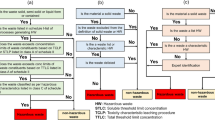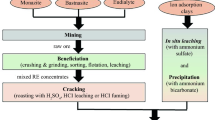Abstract
The long-term safety of radioactive waste repositories in rock-salt mines in the deep underground benefits significantly from the barrier effect of overlying rocks. The concentrations of radioactive substances released from the repository and migrating in the aquifer up to the biosphere are greatly reduced during passage through these rocks. In former safety analyses of waste repositories this transport has generally been modelled as a combination of the involved phenomena, e.g. convection, dispersion, adsorption, etc. The data required for a numerical evaluation of the overall effect are obtained either as (conservative) estimates based on experience or are empirical, based mainly on laboratory experiments. The approach presented here is much simpler and entirely empirical, and therefore more transparent. It makes use of the fact that the groundwater in the overlying rocks always contains dissolved salt from the salt formation and carries it continuously into the receiving channels or the drainage system. The relation between the total amount of dissolved solids present in a certain subsurface catchment area and their steady-state concentration in the receiving channels is assumed to be equivalent to the relation between the given amount of radionuclides released from the repository and their concentration in the receiving channels, the latter leading to a certain radiation exposure of the population. Two versions of this approach are discussed: version (a) assumes a continuous stream of radionuclides released from the repository, and version (b) assumes a pulse release of radionuclides from the repository. A simple calculation using data from the Gorleben exploration leads to the inequality C max(W)≤7.85 · 10−15 W(Bq/l) (1) where C max is the maximum radionuclide concentration (with respect to time) in the receiving channels and W(Bq) is the amount of radionuclides released from the repository in a very short time. C max obtained from (1), is supposed to be an upper limit of the radionuclide concentration in the receiving channel and, therefore, a conservative estimate. In some catchment areas the salt concentration in a small region near the surface is higher by a factor of <2 to 3 than the concentration in the receiving channel. In order to be conservative, this empirical factor may be used to calculate the concentration of radioactive substances. Surprisingly, the values of radiation exposure resulting from both versions of the new approach are far below those calculated by applying elaborated models of the transport processes. The respective factors are 10–100 in case (a) and as much as 1000 in case (b). The reasons for these significant differences are discussed.
Similar content being viewed by others
References
Buhmann D, Nies A, Storck R (1991) Analyse der Langzeitsicherheit von Endlagerkonzepten für wärmeerzeugende radioaktive Abfälle. GSF-Report 27/91, GSF-Forschungszentrum für Umwelt und Gesundheit, Neuherberg, Germany
Leijnse P, Glasbergen P, Nijhoff-Pan I, Sauter F (1988) METROPOL. RIVM 728516003
Gilby DJ, Hopkirk R J (1985) Polydynamics THROUGH-1D, Zürich
Storck R, Aschenbach J, Hirsehorn R, Nies A, Stelte N (1988) Pagis — disposal in salt formation: EUR 11778 EN
Müller H, Pröhl G (1993) ECOSYS-87: a dynamic model for assessing the radiological consequences of nuclear accidents. Health Phys 64:232–252
Bundesamt für Strahlenschutz (1990) Fortschreibung des Zusammenfassenden Zwischenberichtes über bisherige Ergebnisse der Standortuntersuchung Gorleben im Mai 1983. BfS-Bericht ET-2/90, Salzgitter, Germany
Bundesamt für Gewässerkunde (1993) Wasserhaushaltsbericht Gorleben Süd 1983 – 1991. BfG-0735, Koblenz, Germany
Brühl H, Faber P (1983) Beobachtungen zur Versalzung oberflächen-nahen Grundwassers im Naturschutzgebiet Lucie (Kreis Lüchow-Dannenberg). Z Dtsch Geol Ges 134:1055–1067
Klinge H (1994) Archiv-Nr. 111 699. Bundesamt für Geowissenschaften und Rohstoffe, Hannover, Germany
Bear J (1972) Dynamics of fluids in porous media. Elsevier, New York
Memmert G (1996) Die Barrierenwirkung des Deckgebirges im Raum Gorleben. Gewasserkd Mitt 40:16–25
Gupta S, Cole C, Kinraid C, Monti A (1985) CFEST. Battelle Memorial Institute, Columbus, USA
Bütow E, Brühl G, Gülker M, Heredia L, Lütkemeier-Hosseinipour S, Naff R, Struck S (1985) PSE-Abschlußbericht, vol. 18. Hahn-Meitner Institute, Berlin
Holzbecher E (1996) Modellierung dynamischer Prozesse in der Hydrologie: Grundwasser und ungesättigte Zone. Springer, Berlin Heidelberg New York
Author information
Authors and Affiliations
Rights and permissions
About this article
Cite this article
Memmert, G. Nuclear waste repositories in salt mines: a new approach to safety assessment. Radiat Environ Biophys 35, 219–228 (1996). https://doi.org/10.1007/s004110050033
Received:
Accepted:
Issue Date:
DOI: https://doi.org/10.1007/s004110050033




